64 Cores of Rendering Madness: The AMD Threadripper Pro 3995WX Review
by Dr. Ian Cutress on February 9, 2021 9:00 AM EST- Posted in
- CPUs
- AMD
- Lenovo
- ThinkStation
- Threadripper Pro
- WRX80
- 3995WX
CPU Tests: Rendering
Rendering tests, compared to others, are often a little more simple to digest and automate. All the tests put out some sort of score or time, usually in an obtainable way that makes it fairly easy to extract. These tests are some of the most strenuous in our list, due to the highly threaded nature of rendering and ray-tracing, and can draw a lot of power. If a system is not properly configured to deal with the thermal requirements of the processor, the rendering benchmarks is where it would show most easily as the frequency drops over a sustained period of time. Most benchmarks in this case are re-run several times, and the key to this is having an appropriate idle/wait time between benchmarks to allow for temperatures to normalize from the last test.
Blender 2.83 LTS: Link
One of the popular tools for rendering is Blender, with it being a public open source project that anyone in the animation industry can get involved in. This extends to conferences, use in films and VR, with a dedicated Blender Institute, and everything you might expect from a professional software package (except perhaps a professional grade support package). With it being open-source, studios can customize it in as many ways as they need to get the results they require. It ends up being a big optimization target for both Intel and AMD in this regard.
For benchmarking purposes, we fell back to one rendering a frame from a detailed project. Most reviews, as we have done in the past, focus on one of the classic Blender renders, known as BMW_27. It can take anywhere from a few minutes to almost an hour on a regular system. However now that Blender has moved onto a Long Term Support model (LTS) with the latest 2.83 release, we decided to go for something different.
We use this scene, called PartyTug at 6AM by Ian Hubert, which is the official image of Blender 2.83. It is 44.3 MB in size, and uses some of the more modern compute properties of Blender. As it is more complex than the BMW scene, but uses different aspects of the compute model, time to process is roughly similar to before. We loop the scene for at least 10 minutes, taking the average time of the completions taken. Blender offers a command-line tool for batch commands, and we redirect the output into a text file.
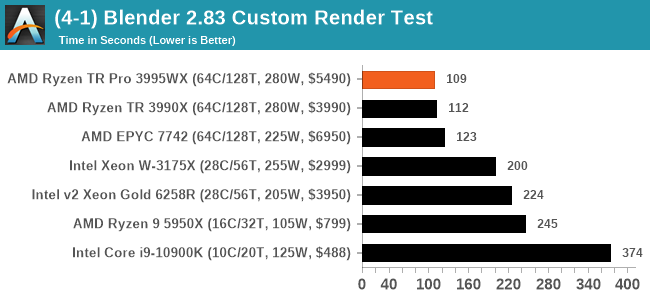
The first benchmark out of the gate and a win is scored by the TR Pro. It's only a small win at around 3%, but it showcases that the eight memory channels outweigh the extra frequency of regular Threadripper here.
Corona 1.3: Link
Corona is billed as a popular high-performance photorealistic rendering engine for 3ds Max, with development for Cinema 4D support as well. In order to promote the software, the developers produced a downloadable benchmark on the 1.3 version of the software, with a ray-traced scene involving a military vehicle and a lot of foliage. The software does multiple passes, calculating the scene, geometry, preconditioning and rendering, with performance measured in the time to finish the benchmark (the official metric used on their website) or in rays per second (the metric we use to offer a more linear scale).
The standard benchmark provided by Corona is interface driven: the scene is calculated and displayed in front of the user, with the ability to upload the result to their online database. We got in contact with the developers, who provided us with a non-interface version that allowed for command-line entry and retrieval of the results very easily. We loop around the benchmark five times, waiting 60 seconds between each, and taking an overall average. The time to run this benchmark can be around 10 minutes on a Core i9, up to over an hour on a quad-core 2014 AMD processor or dual-core Pentium.

Another small 3% win in Corona, and almost double what Intel is offering.
Crysis CPU-Only Gameplay
One of the most oft used memes in computer gaming is ‘Can It Run Crysis?’. The original 2007 game, built in the Crytek engine by Crytek, was heralded as a computationally complex title for the hardware at the time and several years after, suggesting that a user needed graphics hardware from the future in order to run it. Fast forward over a decade, and the game runs fairly easily on modern GPUs.
But can we also apply the same concept to pure CPU rendering? Can a CPU, on its own, render Crysis? Since 64 core processors entered the market, one can dream. So we built a benchmark to see whether the hardware can.
For this test, we’re running Crysis’ own GPU benchmark, but in CPU render mode. This is a 2000 frame test, with medium and low settings.
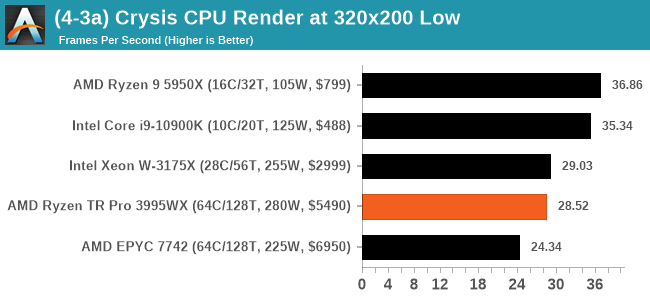
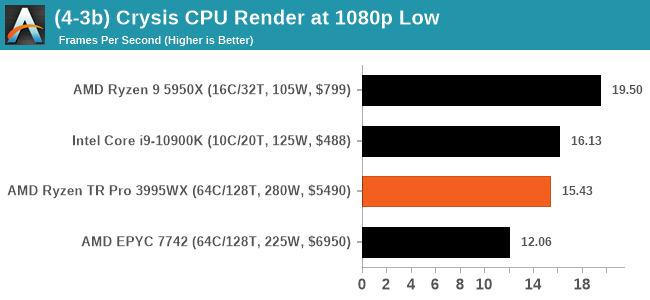
The Crytek engine used for Crysis has two key limitations: up to 32 threads, and up to 23 cores. As a result our high-end CPUs here are pegged to those cores, and single-thread limits come into play. The TR 3995WX has a healthy lead over the EPYC 7742, but loses out against the mainstream processors.
POV-Ray 3.7.1: Link
A long time benchmark staple, POV-Ray is another rendering program that is well known to load up every single thread in a system, regardless of cache and memory levels. After a long period of POV-Ray 3.7 being the latest official release, when AMD launched Ryzen the POV-Ray codebase suddenly saw a range of activity from both AMD and Intel, knowing that the software (with the built-in benchmark) would be an optimization tool for the hardware.
We had to stick a flag in the sand when it came to selecting the version that was fair to both AMD and Intel, and still relevant to end-users. Version 3.7.1 fixes a significant bug in the early 2017 code that was advised against in both Intel and AMD manuals regarding to write-after-read, leading to a nice performance boost.
The benchmark can take over 20 minutes on a slow system with few cores, or around a minute or two on a fast system, or seconds with a dual high-core count EPYC. Because POV-Ray draws a large amount of power and current, it is important to make sure the cooling is sufficient here and the system stays in its high-power state. Using a motherboard with a poor power-delivery and low airflow could create an issue that won’t be obvious in some CPU positioning if the power limit only causes a 100 MHz drop as it changes P-states.
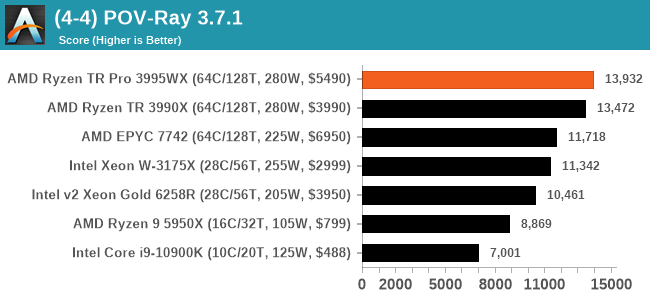
POV-Ray is another 3% win for the TR Pro 3995WX.
V-Ray: Link
We have a couple of renderers and ray tracers in our suite already, however V-Ray’s benchmark came through for a requested benchmark enough for us to roll it into our suite. Built by ChaosGroup, V-Ray is a 3D rendering package compatible with a number of popular commercial imaging applications, such as 3ds Max, Maya, Undreal, Cinema 4D, and Blender.
We run the standard standalone benchmark application, but in an automated fashion to pull out the result in the form of kilosamples/second. We run the test six times and take an average of the valid results.
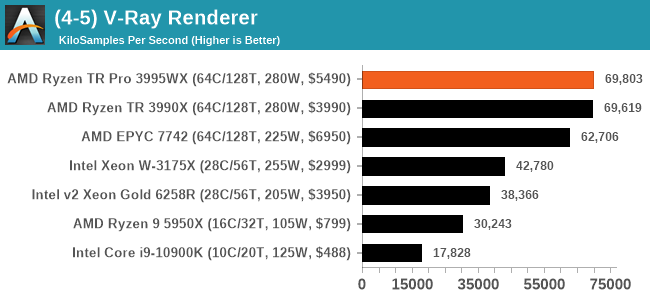
Less than 0.3% win here this time, but AMD's 64-core offerings are still ahead of the game.
Cinebench R20: Link
Another common stable of a benchmark suite is Cinebench. Based on Cinema4D, Cinebench is a purpose built benchmark machine that renders a scene with both single and multi-threaded options. The scene is identical in both cases. The R20 version means that it targets Cinema 4D R20, a slightly older version of the software which is currently on version R21. Cinebench R20 was launched given that the R15 version had been out a long time, and despite the difference between the benchmark and the latest version of the software on which it is based, Cinebench results are often quoted a lot in marketing materials.
Results for Cinebench R20 are not comparable to R15 or older, because both the scene being used is different, but also the updates in the code bath. The results are output as a score from the software, which is directly proportional to the time taken. Using the benchmark flags for single CPU and multi-CPU workloads, we run the software from the command line which opens the test, runs it, and dumps the result into the console which is redirected to a text file. The test is repeated for a minimum of 10 minutes for both ST and MT, and then the runs averaged.
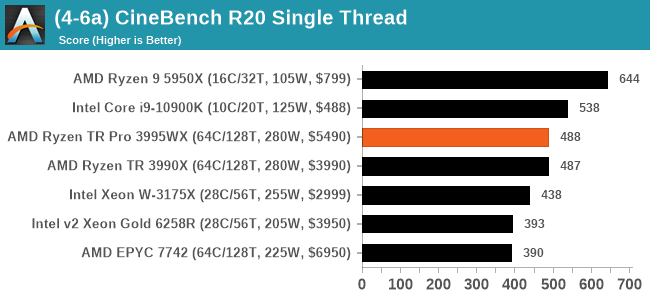
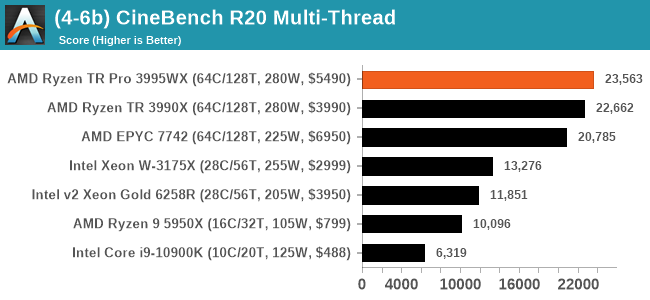
Cinebench ST scores are clearly in the realm of the mainstream processors, but when firing up all the threads, the TR Pro 3995WX takes a 4% lead over the standard 3990X, and scores 2.33x more than the mainstream 16-core Ryzen 9.




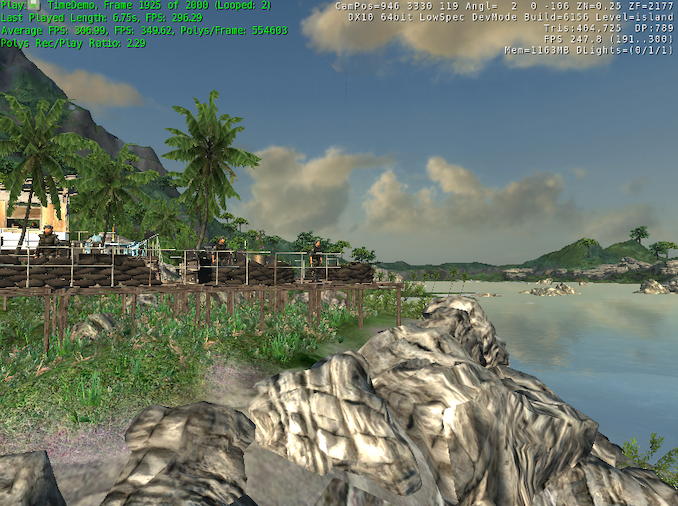











118 Comments
View All Comments
Oxford Guy - Friday, February 12, 2021 - link
Bulldozer was indeed particularly awful. Abstract names like Xeon are generally less annoying than misapplied real-world names.Qasar - Friday, February 12, 2021 - link
too bad bulldozer and netburst were code names for the architecture, and not marketing names like xeon and threadripper.GeoffreyA - Saturday, February 13, 2021 - link
You're right, but even FX and Phenom were in poorer taste than Athlon, which was sheer gold, I'd say. Is Threadripper good or bad as a name? What I say, or anyone else here says, doesn't matter. Only from a survey can we get a better picture, and even there it's a reflection of popular opinion, a blunt instrument, often misled by the times.Is there a standard of excellence, a mode of naming so tuned to the genius of the language that it never changes? It's evident to everyone that "Interstellar" sounds better than "Invisible Invaders from Outer Space," but we could be wrong and time only can decide the matter. If, in 500 years, people still get a shiver when they hear Interstellar, we'll know that Nolan named his film right.
Back to the topic. I think the spirit of Oxford Guy's comment was: TR and Epyc aren't that good names (which I partly agree with). Whether it inspires confidence in professionals is a different matter. A professional might be an expert in their field but it doesn't mean they're an expert on good names (and I'm not claiming I am one either). It matters little: if the target demographic buys, AMD's bank account smiles. But it's a fair question to ask, apart from sales, is a name good or bad? Which were the best? Does it sound beautiful?Names, in themselves, are pleasurable to many people.
jospoortvliet - Saturday, February 13, 2021 - link
Names should have a few properties if they are to be good.Easy to pronounce (cross-culturally!)
Easy to remember (distinctive)
Not (too) silly/funny
Bonus: have some (clever) relation to the actual product.
Threadripper certainly earns the bonus but might arguably perhaps maybe lose out on the 3rd ‘silly’ point. However, in that regards i would argue it makes a difference how well it fulfills that rather ambitious title, and as we all know the answer is “very well”. Now if threadripper was a mediocre product, not at all living up to its name, I’d judge different but as it stands I would say it is a brilliant name.
GeoffreyA - Saturday, February 13, 2021 - link
Good breakdown that, to test names against. Simplicity, too, wins the day.GeoffreyA - Saturday, February 13, 2021 - link
"Bulldozer was indeed particularly awful"One of the worst. AMD's place names were good in the K8 era, and the painter ones are doing a good job too.
danjw - Saturday, February 13, 2021 - link
You may not be aware of this, but Threadripper, is actually comes from the 80's fashion fad of ripped clothing. ;-)GeoffreyA - Saturday, February 13, 2021 - link
Well, I like it even more then, being a fan of the 80s.Hulk - Tuesday, February 9, 2021 - link
Is the difference in output quality strictly due to rounding/numerical errors when using GPU vs CPU or are there differences in the computational algorithms that calculate the numbers?Kjella - Tuesday, February 9, 2021 - link
Not in terms of color accuracy, not a problem making 10/12 bit non-linear color from 32 bit linear - even 16 bit is probably near perfect. But for physics engines, ray tracing etc. errors can compound a lot - imagine a beam of light hitting a reflective surface where fractions of a degree means the light bounces in a completely different direction. Or you're modelling a long chain of events that cause compounding errors, or the sum of a million small effects or whatever. But it can also just be that the algorithms are a bit "lazy" and expect everything to fit because they got 64 bits to play with. I doubt that much needs ~1.0000000001 precision, much less ~1.0000000000000000001.